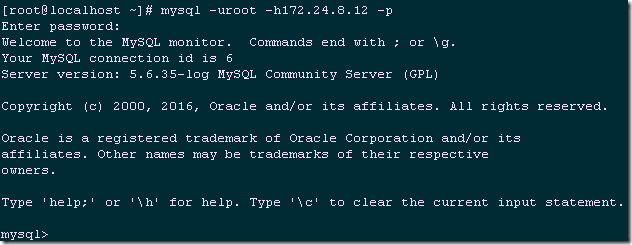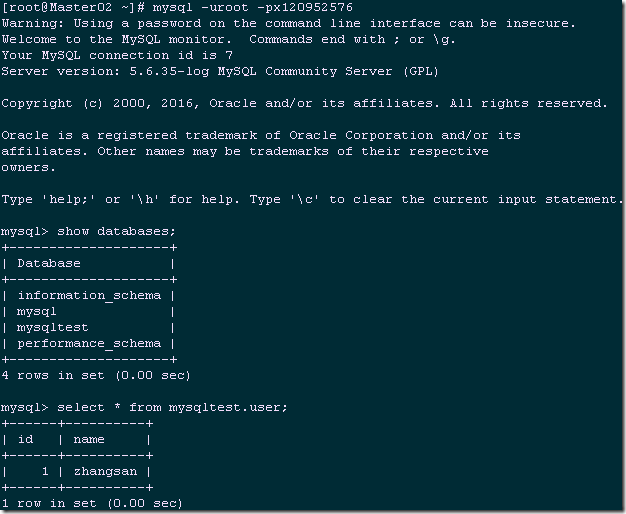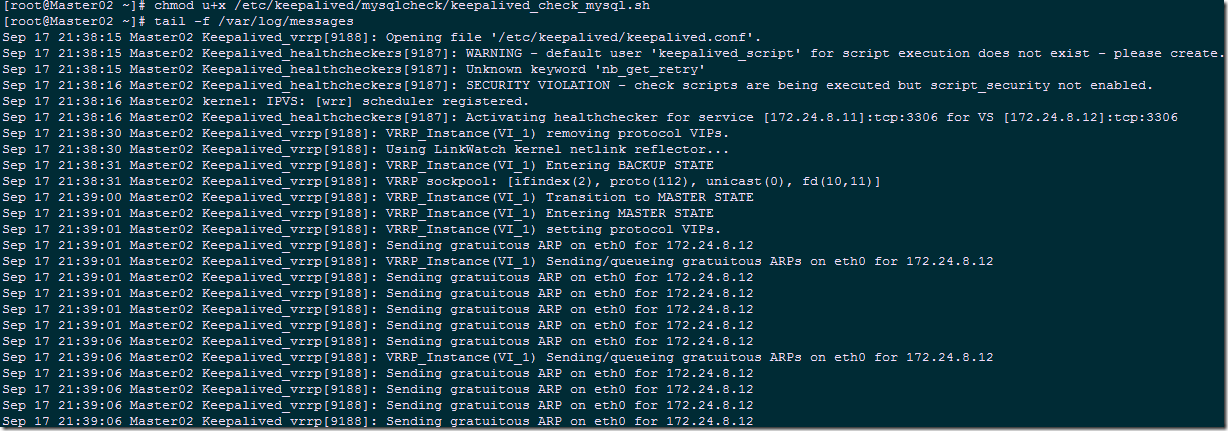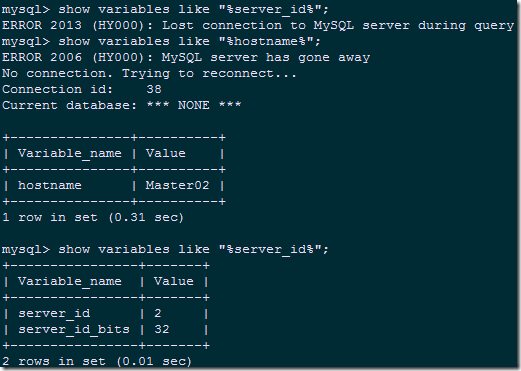一 基础环境
二 实际部署
2.1 安装MySQL
[root@Master01 ~]# yum list installed | grep mysql #查看是否存在其他MySQL组件
[root@Master01 ~]# yum -y remove mysql-libs.x86_64 #为避免冲突引发报错,卸载已存在的组件
[root@Master01 study]# yum localinstall mysql-commu* -y
[root@Master01 ~]# chkconfig --list | grep mysqld #查看MySQL是否加入启动项
[root@Master01 ~]# chkconfig mysqld on
2.2 初始化MySQL
[root@Master01 ~]# service mysqld start
[root@Master01 ~]# mysql_secure_installation
[root@Master01 ~]# service iptables stop
[root@Master01 ~]# chkconfig iptables off
[root@Master01 ~]# vi /etc/sysconfig/selinux
SELINUX=disabled
注意:以上操作在Master02主机上也需要执行。
安装参考:http://tech.souyunku.com/007sx/p/7083143.html
2.3 master01 my.cf配置
[root@Master01 ~]# vi /etc/my.cnf
[mysqld]
……
server-id=1 #设置主服务器master的id
log-bin=mysql-bin #配置二进制变更日志命名格式
replicate-wild-ignore-table=mysql.%
replicate-wild-ignore-table=test.%
replicate-wild-ignore-table=information_schema.%
注意:
master开启二进制日志后默认记录所有库所有表的操作,可以通过配置来指定只记录指定的数据库甚至指定的表的操作,具体在mysql配置文件的[mysqld]可添加修改如下选项:
方法一:
# 不同步哪些数据库
binlog-ignore-db = mysql
binlog-ignore-db = test
binlog-ignore-db = information_schema
# 只同步哪些数据库,除此之外,其他不同步
binlog-do-db = mysqltest
方法二:
建议采用以下方式配置过滤:
replicate-wild-ignore-table=mysql.% #从库配置不同步表
replicate-wild-do-table=test.% #从库配置需要同步的表
提示:不要在主库使用binlog-ignore-db和binlog-do-db,也不要在从库使用replicate-wild-ignore和replicate-wild-do-table。
2.4 创建账号
[root@Master01 ~]# mysql -uroot -p
Enter password:
mysql> grant replication slave on *.* to 'repl_user'@'172.24.8.11' identified by 'x12345678';
mysql> grant all privileges on *.* to 'root'@'172.24.8.%' identified by 'x120952576' with grant option;
mysql> flush privileges;
[root@Master01 ~]# service mysqld restart
[root@Master01 ~]# mysql -uroot -p
Enter password:
mysql> show master status;
master01:
file:mysql-bin.000001
position:120
2.5 smaster02 my.cf配置配置
[root@Master02 ~]# vi /etc/my.cnf
[mysqld]
server-id=2 #设置主服务器master的id
log-bin=mysql-bin #配置二进制变更日志命名格式
replicate-wild-ignore-table=mysql.%
replicate-wild-ignore-table=test.%
replicate-wild-ignore-table=information_schema.%
read_only=1
2.6 创建账号
[root@Master02 ~]# mysql -uroot -p
Enter password:
mysql> grant replication slave on *.* to 'repl_user'@'172.24.8.10' identified by 'x12345678';
mysql> grant all privileges on *.* to 'root'@'172.24.8.%' identified by 'x120952576' with grant option;
mysql> flush privileges;
[root@Master02 ~]# service mysqld restart
[root@Master02 ~]# mysql -uroot -p
Enter password:
mysql> show master status;
master02:
file:mysql-bin.000001
position:120
三 启动主从
3.1 手动同步
如果Master01和Master02已经存在数据,则在开启主备复制之前,需要将Master01和Master02手动同步一次(/var/lib/mysql整个目录打包tar.gz),具体方法略。
注意:本实验都是重新安装的MySQL,可直接启动同步。
3.2 启动Master01的slave功能
[root@Master01 ~]# service mysqld restart
[root@Master01 ~]# mysql -uroot -p
Enter password:
mysql> change master to master_host='172.24.8.11',
master_user='repl_user',
master_password='x12345678',
master_log_file='mysql-bin.000001',
master_port=3306,
master_log_pos=120;
mysql> start slave;
mysql> show slave status\G #查看slave状态
3.3 启动Master02的slave功能
[root@Master02 ~]# service mysqld restart
[root@Master02 ~]# mysql -uroot -p
Enter password:
mysql> change master to master_host='172.24.8.10',
master_user='repl_user',
master_password='x12345678',
master_log_file='mysql-bin.000001',
master_log_pos=120;
mysql> start slave;
mysql> show slave status\G #查看slave状态
提示:
slave的I/O和SQL线程都已经开始运行,而且Seconds_Behind_Master不再是NULL。日志的位置增加了,意味着一些事件被获取并执行了。如果你在master上进行修改,你可以在slave上看到各种日志文件的位置的变化,同样,你也可以看到数据库中数据的变化。
四 安装Keepalived
4.1 下载
[root@Master01 ~]# wget http://www.keepalived.org/software/keepalived-1.3.6.tar.gz
[root@Master01 ~]# tar -zvxf keepalived-1.3.6.tar.gz -C /tmp/
[root@Master01 ~]# cd /tmp/keepalived-1.3.6
[root@Master01 keepalived-1.3.6]# ./configure --prefix=/usr/local/keepalived/ --sysconf=/etc --with-init=SYSV
#注:(upstart|systemd|SYSV|SUSE|openrc) #根据你的系统选择对应的启动方式
[root@Master01 keepalived-1.3.6]# make && make install
[root@Master01 ~]# ln -s /usr/local/keepalived/sbin/keepalived /sbin
[root@Master01 ~]# chmod u+x /etc/init.d/keepalived
[root@Master01 ~]# chkconfig --add keepalived
[root@Master01 ~]# chkconfig --level 35 keepalived on
注意:Master02上也需要如上操作。
若出现以下提示,需要执行:yum -y install openssl-devel。
提示:也可采用yum install -y keepalived安装(个人不建议)。
4.2 Master01配置Keepalived
默认情况下keepalived启动时会去/etc/keepalived目录下找配置文件。
[root@Master01 ~]# vim /etc/keepalived/keepalived.conf
! Configuration File for keepalived
global_defs {
notification_email {
x120952576@126.com
#表示keepalived在发生诸如切换操作时发送Email给哪些地址,邮件地址可以多个,每行一个。
}
notification_email_from Alexandre.Cassen@firewall.loc
smtp_server 172.24.8.10
smtp_connect_timeout 30
router_id LVS_DEVEL
}
vrrp_instance VI_1 {
state BACKUP
interface eth0
virtual_router_id 51
#这里设置VRID,这里非常重要,相同的VRID为一个组,他将决定多播的MAC地址
priority 100
advert_int 1
nopreempt
#不抢占,只在优先级高的机器上设置即可,优先级低的机器不设置
authentication {
auth_type PASS
auth_pass 1111
}
track_script {
check_mysqld #执行定义的监控脚本
}
virtual_ipaddress {
172.24.8.12
}
}
vrrp_script check_mysqld {
script"/etc/keepalived/mysqlcheck/keepalived_check_mysql.sh "
interval 2
}
4.3 创建检测脚本
[root@Master01 ~]# mkdir -p /etc/keepalived/mysqlcheck/
[root@Master01 ~]# vi /etc/keepalived/mysqlcheck/keepalived_check_mysql.sh
#!/bin/bash
MYSQL=/usr/bin/mysql
MYSQL_HOST=localhost
MYSQL_USER=root
MYSQL_PASSWORD=x120952576
CHECK_TIME=3
#mysql is workingMYSQL_OK is 1 , mysql down MYSQL_OK is 0
MYSQL_OK=1
function check_mysql_helth (){
$MYSQL -h $MYSQL_HOST -u $MYSQL_USER -p${MYSQL_PASSWORD} -e "show status;" >/dev/null 2>&1
if [ $? = 0 ] ;then
MYSQL_OK=1
else
MYSQL_OK=0
fi
return $MYSQL_OK
}
while [ $CHECK_TIME -ne 0 ]
do
let "CHECK_TIME -= 1"
check_mysql_helth
if [ $MYSQL_OK = 1 ] ; then
CHECK_TIME=0
exit 0
fi
if [ $MYSQL_OK -eq 0 ] && [ $CHECK_TIME -eq 0 ]
then
/etc/init.d/keepalived stop
exit 1
fi
sleep 1
done
[root@Master01 ~]# chmod u+x /etc/keepalived/mysqlcheck/keepalived_check_mysql.sh
[root@Master01 ~]# service keepalived start
4.4 Master02配置Keepalived
[root@Master01 ~]# scp /etc/keepalived/keepalived.conf root@127.24.8.11:/etc/keepalived/
参考Master01配置,去掉nopreempt选项,priority设置比Master01低即可。
4.5 创建检测脚本
[root@Master02 ~]# mkdir -p /etc/keepalived/mysqlcheck/
[root@Master01 ~]# scp /etc/keepalived/mysqlcheck/keepalived_check_mysql.sh root@172.24.8.11:/etc/keepalived/mysqlcheck/
[root@Master02 ~]# chmod u+x /etc/keepalived/mysqlcheck/keepalived_check_mysql.sh
[root@Master02 ~]# service keepalived start
五 功能测试
5.1 测试vip
[root@test ~]# mysql -uroot -h172.24.8.12 -p
mysql> show variables like "%hostname%";
mysql> show variables like "%server_id%";
5.2 同步测试
[root@test ~]# mysql -uroot -p
Enter password:
mysql> create database mysqltest;
mysql> use mysqltest;
mysql> create table user(id int(5),name char(10));
mysql> insert into user values (00001,'zhangsan');
在Slave从服务器上进行验证:
[root@Master02 ~]# mysql -uroot -p
Enter password:
mysql> show databases;
mysql> select * from mysqltest.user;
5.3 测试Keepalived切换
[root@Master01 ~]# service mysqld stop #停止Master01的MySQL
[root@Master01 ~]# tail -f /var/log/messages #观察Master01的日志
[root@Master02 ~]# tail -f /var/log/messages #观察Master02的日志
[root@Client ~]# mysql -uroot -h172.24.8.12 -px120952576 #客户端连接VIP
注意:已经成功切换,在切换过程中可能中断几秒。











